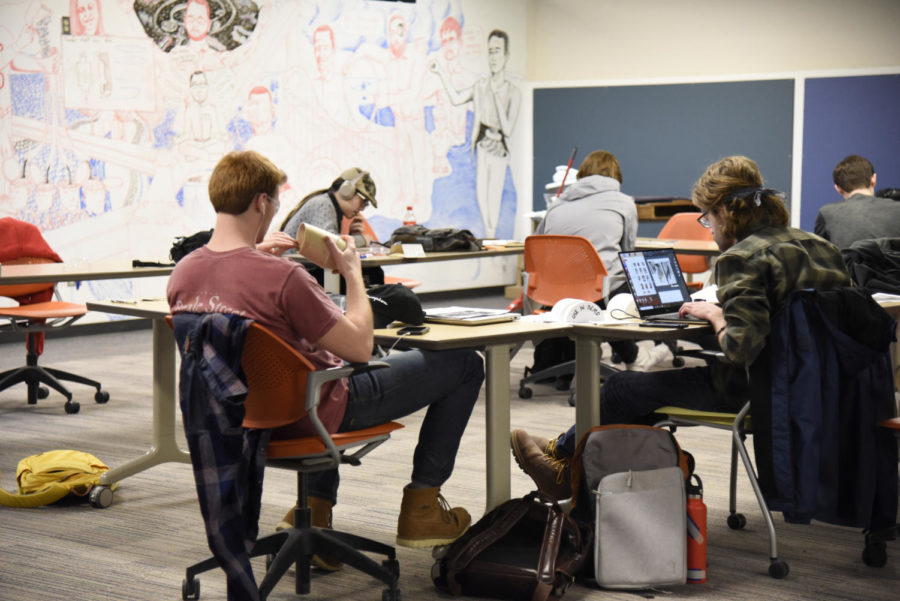College of Design students put in long hours to complete projects and portfolios
March 9, 2020
The work of students in the College of Design can be overlooked as they sit in studios for hours to focus on their projects. The students have different experiences but have one thing in common: they put in a lot of effort to get the job done.
“It looks like a lot of late nights in the studio sitting down on the ground laughing and sometimes crying with the other people that are there, freaking out because you have a week to do an entire project,” said Kyra Troendle, sophomore in community and regional planning. “It’s a lot of seeing people for four or five hours straight and leaving for a half an hour and coming back for another three.”
Students in their first year at the College of Design can put in a lot of hours working on projects, assignments and their final portfolios. Long hours and late nights are not a rare occurrence for students in design.
“I didn’t think my professor was serious when she said, ‘You’re in class six hours, you should be working on it outside of class for six hours,’” Troendle said. “But I remember one week I was averaging six hours in the studio a day.”
Sophia Allen, sophomore in pre-architecture, spends many of her nights in the studio working on her projects.
“One of the latest nights I’ve spent in the [College of Design] was this semester,” Allen said. “A couple nights before a final review, I stayed in the studio working on a project until 8 a.m., where I then took a bus back to my dorm for a few minutes and then went straight to Hobby Lobby to get more supplies. Afterwards, I went to my classes and then back to Design to continue working. It was a very long day, but I managed to get all my stuff done.”
There’s an element of fun that goes into the long hours of work, though. To some students, late nights in the studio can feel like more of a family atmosphere when working with others.
The level of dedication needed by design students is evident in the hours they put in every week and the pressure they have to apply the skills they learn in classes in order to be accepted into the College of Design following their core year.
For most undergraduate paths in the College of Design, the first year of classes is completed through the Core Design Program. This is set up to help students become better designers with the basic foundations and principles that will be necessary in their later studies.
“It’s very overwhelming at first,” Troendle said. “It’s a lot to take in; you kind of just get thrown right into it. Leading up to it, people are always like, ‘Oh, first-year design is the worst, it’s so awful,’ but I had such a positive experience with it.”
In the first-year program, students of all backgrounds and experience levels meet for classes and studios, a dedicated time for students to work on their projects with instructors.
Ryan Poppert, freshman in pre-architecture, said even students who have never taken an art class prior to their college education would still have the opportunity for success because of the structure of the Core Design Program.
“It’s a really cool system because it’s like everyone starts out at step one,” Poppert said. “You can come in with whatever experience you have, but at the end of the day, everyone’s going to be treated equally in the work that they have, and everyone’s going to start at the same spot […].”
Many students in design are required to create a portfolio of their work that they will submit at the end of the school year. The portfolio is a very large piece of criteria that will be looked at for their potential admission into the College of Design and may even be the determining piece in whether or not students will continue their design career at Iowa State.
Following specific guidelines, students include a handful of studio projects in their portfolio.
For some projects, students display their process work, first rough drafts, the final product and a brief description of each project.
Students are required to provide documentation of their process work, pre-design models, brainstorming abilities and an in-depth description of the story behind the art for other specific projects in their portfolio. A small amount of personal work can also be submitted within the portfolio.
Although the program is very competitive at times as students are working to fill the limited amount of seats in the design program they desire to be a part of, collaboration is a pivotal element in the College of Design.
In drawing classes, students participate in “pin-ups,” which provide students with the opportunity to present work to other students in the class. Students are able to view other students’ progress with their projects, ask them questions about their work and processes and find inspiration in their creations.
“You can always learn from the way that other people design and the way that other people let their design thinking take over,” Poppert said. “The best thing about it is that it’s kind of like an all-for-one, one-for-all kind of thing because if you work with the other students in the studios, not only are you making your work better but you’re making their work better and you’re also building a relationship with those individuals.”
Students also participate in critiques, which provide them with the opportunity to receive advice on their projects from College of Design students who are further in their academic years and have taken the core classes in the past.
“We’d do the critiques,” Troendle said. “And everybody’s putting their stuff up, and everyone’s like, ‘Oh my gosh, I love how you did this part of it. I loved how you did that,’ and everybody’s just so positive about it. Even the critique itself was never like, ‘Oh, this is what you’re doing wrong,’ it was always, ‘This is what I want to see you push further to make your artwork look better and what I think can really take it to the next level.’”
Though students put a lot of time and effort into their work while in the College of Design, a lot of students seem to agree it’s all worth it in the end.
“It’s hard; you have to be cut out for it.” Troendle said. “The thing is, already it’s rewarding for me just to see the progress I’ve made already from the end of August to now, about two months out from the end of the school year and hopefully in my long-awaited journey into the [department] of architecture. It’s an amazing program.”
In the end, the hard work can pay off for students when they look at the positive things and allow themselves to focus on the good they can find.
“As much as we like to complain about having to go in and having to do our projects, there’s nothing more rewarding than finishing a project and getting to see it and just feel proud of where you are, remembering the nights that you sat sleep-deprived in the studio working on it,” Troendle said. “There’s this sense of pride that you get from it, which is so great. It seems really overwhelming when you start it, but it’s one of the best experiences.”

















